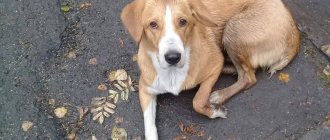Many owners who often travel with animals are familiar with the situation when driving becomes torture due to the fact that the dog gets sick in the car. Many dogs suffer from motion sickness syndrome or kinetosis. At risk are young animals with an immature vestibular apparatus. But for various reasons, adults can also suffer from painful symptoms. If your dog gets sick in the car and you don’t know what to do, then read our article. There are many ways to combat kinetosis along the way. And the sooner this fight begins, the greater the chance that the dog will feel good and the journey will be enjoyable.
How motion sickness occurs
The weakness of the vestibular apparatus lies in the imperfection of the adaptation mechanisms of the central nervous system in the puppy. This is manifested by a mismatch of impulses going to the brain from organs that record changes in the position of the body in space. These are vision, muscles and vestibular apparatus.
The vestibular apparatus is a part of the inner ear that regulates the dog's balance and is responsible for its spatial orientation. Since the vestibular system is connected to the organ of vision, it is important that visual perception corresponds to the signals coming from the vestibular receptors. The information is sent to the brain, which signals the muscles to change body position to restore balance.
Motion sickness is a consequence of the receipt of contradictory information into the brain from the eyes and vestibular receptors during movement (when the eyes record movement and the body is at rest). Spatial orientation is disrupted, the brain provides information about the stressful situation in the body. The autonomic system reacts to this condition with symptoms of a neurological, cardiovascular and digestive nature.
Nature of motion sickness and symptoms
Motion sickness (kinetosis) is associated with the development of dizziness and nausea, which manifest themselves in response to signals from the vestibular apparatus, located in the inner ear, to the brain. Each change in the dog’s body position is accompanied by the transmission of corresponding information through the vestibular apparatus to the brain, where it is processed and further distributed commands to muscles and body parts to restore balance.
When shaking while driving, the vestibular apparatus sends impulses to the brain in a chaotic manner. The brain also receives additional impulses from the organs of vision and movement. If the information coming from the eyes contradicts other impulses, for example, the eyes give a signal that the dog is moving, while the paws are standing still, then motion sickness appears.
Similar chaos occurs when poisons enter the body, which disrupt the flow of impulses. He gets rid of poisons by vomiting, which is why a similar reaction occurs to shaking.
You can determine that your pet is getting carsick by the following symptoms:
- excessive salivation (hypersalivation);
- increased breathing, constant swallowing and nose licking;
- trembling in the body, restless behavior, constant change of body position;
- belching and vomiting.
Some animals have one symptom, others have all of the above. If you notice at least one of them, then your dog is suffering from motion sickness and needs help.
Symptoms of motion sickness
Symptoms of motion sickness resemble signs of severe poisoning of the body or intoxication. This happens because disturbances in the supply of impulses carrying information about the position of the body in space resemble the effect of toxic substances on the brain. The body's protective reaction to both of these conditions is the same.
The main symptoms are:
- severe dizziness;
- nausea and vomiting;
- cardiopalmus;
- increased salivation;
- restlessness (the dog constantly changes body position);
- weakness and lethargy.
What to do if your dog gets sick in the car
Of course, the situation when your four-legged friend is susceptible to motion sickness does not bring much joy. But this does not mean that you should give up on carpooling. The situation is not hopeless, and the following tips will help you determine what to do when your dog vomits while riding in a car:
- try not to feed your dog on the eve of your trip. Feed your dog at least two to three hours before getting into the car;
- introduce the practice of walking with your pet before a road trip;
- during the trip, slightly open the window where the dog is located - access to fresh air will reduce the discomfort of being in the car, especially for dogs with thick hair/undercoat;
- try to move without sudden braking/acceleration - this is one of the most significant factors provoking kinetosis;
- Tobacco smoke is also considered an unfavorable factor, so try not to smoke in the presence of the dog. Dogs are known to be quite sensitive to odors, so strong fresheners have the same adverse effects on them - keep this in mind;
- It is believed that loud sounds, especially music, can also have a negative effect on VA, although no studies have been conducted on this topic;
- If adult dogs are able to withstand even fairly long trips, then with young dogs everything is much worse. Therefore, if your puppy gets carsick in the car, stop often and let him out to run around a little and go to the toilet. Quench thirst - this should bring the vestibular apparatus back to normal.
If you have tried all the methods described above, and they turned out to be ineffective either alone or in combination with others, you can only use special medications, the action of which is aimed at relieving the signs of kinetosis.
Causes of motion sickness
Motion sickness is caused by both medical and behavioral factors.
Medical factors represent various disorders of the vestibular apparatus, as well as some conditions of the body:
- Imperfection of the vestibular apparatus due to young age. In this case, motion sickness torments puppies under the age of 1 year. Then the problem gradually disappears on its own.
- Pathologies of the vestibular system that affect motion sickness include complications after otitis media, traumatic brain injuries, wax plugs in the ears, vestibular neuritis, and tumor diseases of the inner ear.
- Pregnancy. The body experiences special stress during pregnancy, which can also manifest itself as motion sickness in transport.
- Taking certain medications as indicated. This is especially true for drugs used for neurological diseases, some antibiotics and sulfonamides.
Behavioral factors include the following:
- Stressful conditions, fear of a running engine, the smell of gasoline, flickering outside the windows.
- Negative experience of the first trip, if it was associated with an unpleasant event for the dog (visiting a veterinary clinic).
- The motion sickness reflex, which is formed as a result of fear and unpleasant expectations. Nausea can occur already in the cabin, while the car is still standing still.
Why does a dog get sick?
The problem of motion sickness in transport, not only for people, but also for pets, is widespread. The dog may feel sick, vomit, and increase salivation. The pet begins to breathe frequently, usually through the mouth, constantly swallows saliva, and licks its nose. Breathing quickens, the dog looks exhausted and unhealthy. The trip turns into torture for both the animal and its owner.
Most often, puppies under the age of one year, whose vestibular apparatus is not yet fully formed, get motion sickness and car sickness. Veterinarians associate kinetosis with attacks of dizziness. From the vestibular apparatus, which is located in the dog’s inner ear, the signal enters the brain. The organ processes information and transmits a command to the muscles of the body to restore balance.
At the same time, the brain receives signals from the organ of vision. The brain tries to analyze the information received: the dog sees stationary objects inside the car, and when it looks out the window, the surrounding objects are moving. An imbalance arises between vision (perceiving static) and the brain (receiving information about movement).
Important!
Often, motion sickness has a psychological cause - when the puppy’s first trip in the car was associated with a negative experience.
For example, for the first time a puppy was taken by car to the veterinarian, where he was given an injection, tests were taken - in a word, he was hurt. Or the puppies were taken to the forest to be abandoned there. The puppies were saved, but the memories of hungry and cold days and nights will be associated with the car ride for a long time.
With age, kinetosis (as motion sickness is scientifically called) can go away on its own if its cause was only an imperfection of the animal’s vestibular apparatus. But often the problem becomes behavioral. And then even approaching a car can cause panic in the dog.
Solution
The problem of motion sickness in the car can be solved in several ways, depending on the cause. But in any case, it is better to consult a veterinarian about the most appropriate method of correction in this particular case:
- If your dog gets carsick due to his young age, then you can train his vestibular system by taking him on trips more often. Moreover, the first trips should be short and smooth, not containing sharp turns. With age, the baby’s body will get stronger, and his vestibular apparatus will receive the necessary training.
- The medical problem of motion sickness will be solved after the pet recovers and the vestibular system returns to normal.
- The behavioral problem is solved by changing unpleasant associations from a trip to joyful ones. The situation will be corrected by vacation trips with active games and delicious food. A little treat in the car won't hurt either.
- In all cases, before the trip, you need to prepare the dog’s nervous system with mild sedatives, which must be given two to three days before the trip.
How to avoid problems when traveling
The pet must be accustomed to driving gradually: at first it is recommended to practice short car trips around the house and to the store. Then - start taking the dog to places that do not cause concern: to a pond for swimming, outside the city for a walk or a sports ground.
The duration of the trip should not exceed a few minutes, then the distances are gradually increased. After returning the pet, you need to praise it for its good behavior and give it a treat to reinforce the positive associations.
If you have a long trip by transport, you need to prepare thoroughly and follow certain rules along the way:
- 6–8 hours before the trip, do not feed the animal, but be sure to take it for a long walk.
- Place the dog so that it can see the road and get access to fresh air. The best place is in the back seat or at the foot of the front seat passenger. You should not carry your pet on the floor in the back. It is possible to transport your dog in the trunk if it is an SUV or station wagon.
- You cannot secure the neck with a leash; if you turn sharply, this can lead to suffocation.
- On the way, stop periodically to walk your pet and give it water.
- Avoid any actions that could have an additional irritating effect: loud music, the annoying smell of cologne, air fresheners, tobacco smoke.
- Drive smoothly and carefully, avoid sudden braking and turning.
- Constantly reassure your pet, pet it, talk to it calmly.
The problem of motion sickness is sometimes associated not with anatomical features, but with behavioral ones. For example, for the very first time, the puppy was taken by car to a veterinary clinic to get vaccinated, then IVs and injections were prescribed. This negative experience is firmly fixed in the brain of the animal, for which the machine becomes an incomprehensible device that evokes unpleasant memories.
How to behave while traveling
In order for the animal’s body to endure the trip as easily as possible, certain conditions must be met to make the dog feel comfortable:
- Remove all irritants: air fresheners in the cabin, loud music.
- Fresh air helps a lot with motion sickness. It is useful to open the windows in the car; you should not smoke on the road.
- It is not recommended to feed your animal nutritiously before traveling. The best option is a light meal a few hours before departure.
- The dog should have a comfortable place. Perhaps it will be easier for her if she sits in her owner’s arms, in the front seat and looks forward as the vehicle moves.
- During a long trip, it is recommended to stop every 1.5-2 hours to give the animal a rest and stretch.
- You should give your pet water often.
- It is important to calm the dog by stroking it and talking to it gently.
- If these measures do not help and your dog gets sick on the road, you can use motion sickness tablets for dogs.
Tips before your trip
If your dog is prone to motion sickness, this does not mean that you will have to completely give up traveling together. The following tips will help reduce discomfort for your animal during the trip:
- Do not feed the animal before the road. The last meal should be no later than 2 hours before departure.
- Give your pet a good walk before heading out on the road.
- When driving, leave a window slightly open to allow fresh air to enter.
- Avoid sharp turns, acceleration and braking.
- Don't smoke in the car.
- Turn off the radio.
- Remove air fresheners with strong odors and avoid wearing perfume.
- Start training your animal by moving short distances and increase their duration over time.
- During long journeys, make regular stops so that the dog can get out of the car, run, drink water, and go to the toilet.
It is worth noting that these tips really help some, but do not give any effect to others. For such animals, special medications should be used aimed at preventing kinetosis or its individual symptoms.
Drug correction of symptoms
Some medications help improve the condition of the animal in the car. Veterinary pharmacology can offer a whole range of special medications for motion sickness in transport. Having different pharmacological effects, they have a common indication for use - combating motion sickness. The most famous of them are the following drugs:
- Sereniya is an excellent remedy for motion sickness in all types of transport for dogs. This is an antiemetic drug with the active ingredient maropitant citrate. The drug is taken an hour before the trip, is a low-toxic drug, and has the ability to accumulate with repeated use.
- Racefit is an antiemetic drug based on cyclizine hydrochloride, a substance that has an antihistamine and antispasmodic effect. The ability of the hormone histamine to spasm the smooth muscles of the stomach walls is suppressed, which is the cause of vomiting. The drug is not intended for small breed dogs.
- Sanal Relax is a sedative based on the amino acid tryptophan. Reduces nausea and vomiting because it has a sedative effect.
- Avia-sea is a homeopathic remedy for motion sickness for people and dogs. The main pharmacological effect is the stabilization of vestibular disorders. Can be used both for the treatment and prevention of motion sickness. The medicine has virtually no side effects or contraindications.
- Dramamine is an antihistamine drug. The active ingredient, dimenhydrinate, prevents nausea by blocking the production of histamine. Used to correct discomfort when traveling in different types of transport. Used for both dogs and people.
Motion sickness medications for dogs
If your pet does not show signs of motion sickness, but is very nervous and restless, you can use drugs with a sedative effect:
- Fitex - drops based on plant extracts that have a calming effect, relieve irritability, anxiety and fear associated with stressful situations, including transportation, diagnostic procedures and other cases.
- Stop-stress – contains tranquilizers, so it is important to strictly adhere to the dosage. It can cause drowsiness and lethargy, so it is suitable for use only in cases of obvious stress, and not for its prevention. Not suitable for dogs under one year old, pregnant and lactating females, as well as those with diabetes, liver disease, genitourinary system, or oncology. Dosage is calculated depending on weight.
You can now view the current price of the drug and buy it right here:
In any case, you should not give sedatives intended for humans, since animals react differently to medications and it is not always possible to calculate the correct dosage.
For some representatives of small breeds, it will be effective to use special bags or carriers when traveling, where they feel more comfortable and protected.
In the case of severe motion sickness, which, in addition to restless behavior, is accompanied by drooling and vomiting, it is recommended to correct these symptoms with medications. They have different effects, so a competent veterinarian will help you choose the right drug for your dog. The most popular are:
- "Serenia" (Pfizer or Zoetis) - tablets based on maropitant - a substance with an antiemetic effect. They neutralize the symptoms of nausea and vomiting, but do not have a depressant effect on the central nervous system, so the dog remains active and alert after consuming them. The dosage is 8 mg of active substance per kilogram of weight. Before use, you need to feed your pet a little, and then put the tablet on the root of the tongue and make sure that it is swallowed. “Serenia” is given no later than an hour before departure and is valid for 12 hours.
- Reisfit (Beaphar) - tablets based on cyclizine HCl, which suppresses the action of substances that cause spasm of the smooth muscles of the stomach walls, which causes vomiting. The dosage is 4 mg per kilogram. The drug is not recommended for use with a body weight of up to 2.5 kg, so it is not suitable for small breed dogs. The tablets are given half an hour before departure, and if motion sickness occurs again, the dose is repeated after 6 hours. Reisfit can be given no more than 3 times per day.
- Relax (Sanar) - tablets based on tryptophan, which stimulates the production of serotonin, which has a calming effect and suppresses nausea. The drug also reduces the effects of stressful situations associated with traveling and changing places for the dog. For animals weighing up to 5 kg, the dosage is 1-2 tablets, 5-15 kg - 2-4 tablets, and over 15 kg - 4-6 tablets. You can repeat the reception after 5-6 hours.
Prevention measures
The best measure to prevent motion sickness for individuals with a weak vestibular apparatus is its training. This can be done in several ways:
- regularly driving a car for short distances without sharp turns and braking;
- walks with active games, and running with a sharp change of direction.
Seasoned active dogs, in good physical shape, accustomed to moving a lot, trained, on duty, used in hunting, as a rule, do not know such a problem as motion sickness in transport.
Why does a dog get sick in the car?
When considering the problem of kinetosis in dogs, it should be noted that the general trends are not much different from those in humans. In particular, most often the pathology is detected in puppies less than a year old, and the main reason for this is age-related imperfection of the vestibular apparatus, as in humans. As you grow older, the disease becomes less and less pronounced, however, here too everything is purely individual. Some dogs can easily tolerate even long trips; for others, even a short trip is accompanied by the appearance of symptoms characteristic of kinetosis.
The causes of motion sickness can be either physiological or behavioral.
It is noteworthy that a natural predisposition to seasickness can be aggravated, and to a significant extent, by the first negative experience of traveling in a car. As a rule, the puppy is first put into the car to be taken to the veterinary clinic for vaccinations or in case the pet becomes ill. The car itself will be remembered in the puppy’s memory as a kind of loud and foul-smelling room, associated with a trip to an extremely unpleasant place where he was hurt. And if you add motion sickness to this, then such a negative experience will discourage you from getting into a vehicle for a long time.
Each subsequent trip will be accompanied by stress, which will most likely provoke kinetosis. Attacks of nausea can occur even before the car starts moving, as soon as the puppy sits in the back seat, and in rare cases, before getting into the car.
The problem can be solved, but for this you need to show maximum patience. You should do the opposite, that is, try to reinforce the puppy’s positive emotions from traveling in the car. This is achieved by transporting the dog to events that will be associated only with positive things - for example, for walks, to the forest, to the river, to the exercise area.
What to do and how to prepare for the trip
If you don’t know whether your dog can get sick in the car, but postponing the trip or choosing another method of travel is not an option, you should approach the preparation correctly. A few simple tips will help alleviate as much as possible or completely eliminate ailment and discomfort:
- the last feeding before the trip should be no later than 6 hours;
- eliminate external irritants - interior freshener, fragrance, perfume, refrain from smoking in the cabin while driving;
- try to provide a calm environment - loud music, noisy conversations, active gestures should be avoided;
- Before the trip, walk a little longer than usual so that the dog gets tired;
- take your pet’s favorite toy into the car;
- try to drive the car smoothly, without jerking;
- on long trips, make stops more often, giving your pet the opportunity to rest and get some air;
- Keep the windows of the car slightly open so that air constantly circulates in the cabin.
If suddenly for the first time you encounter the fact that your dog is seasick, you should stop, take him out into the air, let him rest, and offer him water. If it is possible to stop or shorten your trip, do so. For your next trips, start preparing in advance, gradually teaching your dog not to be afraid of the car and to feel comfortable. There are simple recommendations for this. Preparation will take some time, which depends on the individual characteristics of each dog. Where to begin:
- Feed the dog in the car - it should get used to the car and not show anxiety;
- After the first step is successfully completed, try feeding your pet in the car, but with the engine running. The dog must get used to the noise of the engine and stop reacting to it.
- The next step is short trips. You can drive around the block, ride around the yard. While driving, talk calmly to your dog, letting him know that everything is going well, he is safe and you are happy with his behavior. You can treat her with a small piece of her favorite treat as a reward.
- The next trips may be longer, but they will definitely evoke positive emotions and then associations. This could be going for a walk, a class, or any place where the dog feels comfortable and happy.
Be sure to teach your dog to only get out of the car on command. Also use safety equipment while driving - a belt, a harness.











